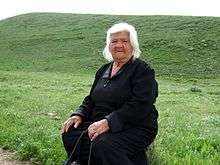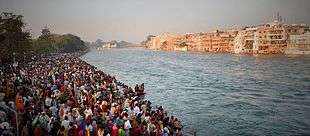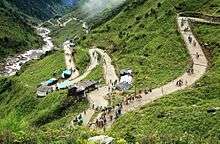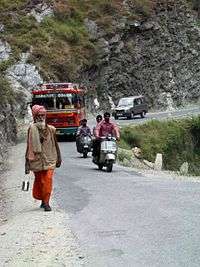Pilgrimage

A pilgrimage is a journey or search of moral or spiritual significance. Typically, it is a journey to a shrine or other location of importance to a person's beliefs and faith, although sometimes it can be a metaphorical journey into someone's own beliefs. Many religions attach spiritual importance to particular places: the place of birth or death of founders or saints, or to the place of their "calling" or spiritual awakening, or of their connection (visual or verbal) with the divine, to locations where miracles were performed or witnessed, or locations where a deity is said to live or be "housed", or any site that is seen to have special spiritual powers. Such sites may be commemorated with shrines or temples that devotees are encouraged to visit for their own spiritual benefit: to be healed or have questions answered or to achieve some other spiritual benefit. A person who makes such a journey is called a pilgrim. As a common human experience, pilgrimage has been proposed as a Jungian archetype by Wallace Clift and Jean Dalby Clift.[1]
The Holy Land acts as a focal point for the pilgrimages of the Abrahamic religions of Judaism, Christianity, and Islam. According to a Stockholm University study in 2011, these pilgrims visit the Holy Land to touch and see physical manifestations of their faith, confirm their beliefs in the holy context with collective excitation, and connect personally to the Holy Land.[2]
Bahá'í Faith
Bahá'u'lláh decreed pilgrimage to two places in the Kitáb-i-Aqdas: the House of Bahá'u'lláh in Baghdad, Iraq, and the House of the Báb in Shiraz, Iran. Later, `Abdu'l-Bahá designated the Shrine of Bahá'u'lláh at Bahji, Israel as a site of pilgrimage.[3] The designated sites for pilgrimage are currently not accessible to the majority of Bahá'ís, as they are in Iraq and Iran respectively, and thus when Bahá'ís currently refer to pilgrimage, it refers to a nine-day pilgrimage which consists of visiting the holy places at the Bahá'í World Centre in northwest Israel in Haifa, Acre, and Bahjí.[3]
Buddhism


There are four places that Buddhists pilgrimage to:
- Lumbini: Buddha's birthplace (in Nepal)
- Bodh Gaya: place of Enlightenment
- Sarnath: where he delivered his first teaching
- Kusinara: (now Kusinagar, India) where he attained mahaparinirvana (died).
Other pilgrimage places in India and Nepal connected to the life of Gautama Buddha are: Savatthi, Pataliputta, Nalanda, Gaya, Vesali, Sankasia, Kapilavastu, Kosambi, Rajagaha, Varanasi, Sabari mala.
Other famous places for Buddhist pilgrimage include:
- India: Sanchi, Ellora, Ajanta.
- Thailand: Sukhothai, Ayutthaya, Wat Phra Kaew, Wat Doi Suthep.
- Tibet: Lhasa (traditional home of the Dalai Lama), Mount Kailash, Lake Nam-tso.
- Cambodia: Angkor Wat, Silver Pagoda.
- Sri Lanka: Polonnaruwa, Temple of the Tooth (Kandy), Anuradhapura.
- Laos: Luang Prabang.
- Malaysia: Kek Lok Si, Cheng Hoon Teng, Maha Vihara
- Myanmar: Bagan, Sagaing Hill.
- Nepal: Boudhanath, Swayambhunath.
- Indonesia: Borobudur.
- China: Yung-kang, Lung-men caves. The Four Sacred Mountains
- Japan:
- Shikoku Pilgrimage, 88 Temple pilgrimage in the Shikoku island.
- Japan 100 Kannon, pilgrimage composed of the Saigoku, Bandō and Chichibu pilgrimages.
- Saigoku 33 Kannon, pilgrimage in the Kansai region.
- Bandō 33 Kannon, pilgrimage in the Kantō region.
- Chichibu 34 Kannon, pilgrimage in Saitama Prefecture.
- Chūgoku 33 Kannon, pilgrimage in the Chūgoku region.
- Kumano Kodō
- Mount Kōya.
Christianity

Christian pilgrimage was first made to sites connected with the birth, life, crucifixion and resurrection of Jesus. Aside from the early example of Origen in the third century, surviving descriptions of Christian pilgrimages to the Holy Land date from the 4th century, when pilgrimage was encouraged by church fathers including Saint Jerome, and established by Helena, the mother of Constantine the Great.[4]
Pilgrimages were, and are, also made to Rome and other sites associated with the apostles, saints and Christian martyrs, as well as to places where there have been apparitions of the Virgin Mary. A popular pilgrimage journey is along the Way of St. James to Santiago de Compostela, in Galicia, Spain, where the shrine of the apostle James is located. Chaucer's The Canterbury Tales recounts tales told by Christian pilgrims on their way to Canterbury Cathedral and the shrine of Thomas Becket.
Hinduism



According to Karel Werner's Popular Dictionary of Hinduism, "most Hindu places of pilgrimage are associated with legendary events from the lives of various gods.... Almost any place can become a focus for pilgrimage, but in most cases they are sacred cities, rivers, lakes, and mountains."[5] Hindus are encouraged to undertake pilgrimages during their lifetime, though this practice is not considered absolutely mandatory. Most Hindus visit sites within their region or locale.
- Kumbh Mela: Kumbh Mela is one of the largest gatherings of humans in the world.[6][7][8] The location is rotated among Allahabad, Haridwar, Nashik, and Ujjain.
- Char Dham (Famous Four Pilgrimage sites): The four holy sites Puri, Rameswaram, Dwarka, and Badrinath (or alternatively the Himalayan towns of Badrinath, Kedarnath, Gangotri, and Yamunotri) compose the Char Dham (four abodes) pilgrimage circuit.
- Old Holy cities as per Puranic Texts: Varanasi formerly known as Kashi, Allahabad formerly known as Prayag, Haridwar-Rishikesh, Mathura-Vrindavan, Pandharpur, Paithan and Ayodhya.
- Major Temple cities: Puri, which hosts a major Vaishnava Jagannath temple and Rath Yatra celebration; Katra, home to the Vaishno Devi temple; Three comparatively recent temples of fame and huge pilgrimage are Shirdi, home to Sai Baba of Shirdi, Tirumala - Tirupati, home to the Tirumala Venkateswara Temple; and Sabarimala,where Swami Ayyappan is worshipped.
- Shakti Peethas: Another important set of pilgrimages are the Shakti Peethas, where the Mother Goddess is worshipped, the two principal ones being Kalighat and Kamakhya.
Islam

The pilgrimage to Mecca (Hajj) is one of the five pillars of Islam and a mandatory religious duty for Muslims that must be carried out at least once in their lifetime by all adult Muslims who are physically and financially capable of undertaking the journey, and can support their family during their absence.[9][10][11] The gathering during the Hajj is considered the largest annual gathering of people in the world.[12][13][14]
Another important place for Muslims is the city of Medina, the second holiest site in Islam, in Saudi Arabia, the final resting place of Muhammad in Al-Masjid al-Nabawi (Mosque of the Prophet).[15]
The Ihram (white robes of pilgrimage) is meant to show equality of all Muslim pilgrims in the eyes of God, that there is no difference between a prince and a pauper. Ihram is also symbolic for holy virtue and pardon from all past sins.
Arba'een
Arba'een (Arabic: الأربعين, "forty"), Chehelom (Persian: چهلم, Urdu: چہلم, "the fortieth [day]") or Qirkhi, Imamin Qirkhi (Azerbaijani: İmamın qırxı, امامین قیرخی, "the fortieth of Imam") is a Shia Muslim religious observance that occurs forty days after the Day of Ashura. It commemorates the martyrdom of Husayn ibn Ali, the grandson of Muhammad, which falls on the 20th or 21st day of the month of Safar. Imam Husayn ibn Ali and 72 companions were killed by Yazid I's army in the Battle of Karbala in 61 AH (680 CE). Arba'een or forty days is also the usual length of mourning after the death of a family member or loved one in many Muslim traditions. Arba'een is one of the largest pilgrimage gatherings on Earth, in which up to 31 million people go to the city of Karbala in Iraq.[16][17][18][19]
Imam Reza
The second largest holy city in the world, Mashhad attracts more than 20 million tourists and pilgrims every year, many of whom come to pay homage to the Imam Reza shrine (the eighth Shi'ite Imam). It has been a magnet for travelers since medieval times.[20]
Judaism

While Solomon's Temple stood, Jerusalem was the centre of the Jewish religious life and the site of the Three Pilgrimage Festivals of Passover, Shavuot and Sukkot, and all adult men who were able were required to visit and offer sacrifices (korbanot) at the Temple. After the destruction of the Temple, the obligation to visit Jerusalem and to make sacrifices no longer applied. The obligation was restored with the rebuilding of the Temple, but following its destruction in 70 CE, the obligation to make a pilgrimage to Jerusalem and offer sacrifices again went into abeyance.
The western retaining wall of the Temple Mount, known as the Western Wall or 'Wailing' Wall, remains in the Old City of Jerusalem and is the most sacred and visited site for Jews. Pilgrimage to this area was off-limits to Jews from 1948 to 1967, when East Jerusalem was under Jordanian control.
There are numerous lesser Jewish pilgrimage destinations, mainly tombs of tzadikim, throughout the Land of Israel and all over the world, including: Hebron; Bethlehem; Mt. Meron; Netivot; Uman, Ukraine; Silistra, Bulgaria; Damanhur, Egypt; and many others.[21]
Sikhism
The Sikh religion does not place great importance on pilgrimage. Guru Nanak Dev was asked "Should I go and bathe at pilgrimage places?" and replied: "God's name is the real pilgrimage place which consists of contemplation of the word of God, and the cultivation of inner knowledge."
Eventually, however, Amritsar and Harmandir Saheb (the Golden Temple) became the spiritual and cultural centre of the Sikh faith, and if a Sikh goes on pilgrimage it is usually to this place.[22]
Zoroastrianism
In Iran, there are pilgrimage destinations called pirs in several provinces, although the most familiar ones are in the province of Yazd. In addition to the traditional Yazdi shrines, new sites may be in the process of becoming pilgrimage destinations. The ruins are the ruins of ancient fire temples. One such site is the ruin of the Sassanian era Azargoshasb Fire Temple in Iran's Azarbaijan Province. Other sites are the ruins of fire temples at Rey, south of the capital Tehran, and the Firouzabad ruins sixty kilometres south of Shiraz in the province of Pars.
In India the cathedral fire temple that houses the Iranshah Atash Behram, located in the small town of Udvada in the west coast province of Gujarat, is a pilgrimage destination.
Meher Baba
The main pilgrimage sites associated with the spiritual teacher Meher Baba are Meherabad, India, where Baba completed the "major portion"[23] of his work and where his tomb is now located, and Meherazad, India, where Baba resided later in his life.
See also
- Burial places of founders of world religions
- HCPT – The Pilgrimage Trust
- Junrei
- List of shrines
- List of significant religious sites
- Monastery
- Pardon (ceremony)
- Romeria
- Sacred travel
- World Youth Day
Notes
- ↑ Cleft, Jean Darby; Cleft, Wallace (1996). The Archetype of Pilgrimage: Outer Action With Inner Meaning. The Paulist Press. ISBN 0-8091-3599-X.
- ↑ Metti, Michael Sebastian (2011-06-01). "Jerusalem - the most powerful brand in history" (PDF). Stockholm University School of Business. Retrieved 1 July 2011.
- 1 2 Smith, Peter (2000). "Pilgrimage". A concise encyclopedia of the Bahá'í Faith. Oxford: eworld Publications. p. 269. ISBN 1-85168-184-1.
- ↑ Ltd, Eternal City Group. "Passion of Christ Tour - Eternal City Tours". eternalcitytours.com. Retrieved 30 October 2016.
- ↑ Werner, Karel (1994). A popular dictionary of Hinduism. Richmond, Surrey: Curzon. ISBN 0700702792. Retrieved 30 October 2016.
- ↑ Thangham, Chris V. (2007-01-03). "Photo from Space of the Largest Human Gathering in India". Digital Journal. Retrieved 2014-03-22.
- ↑ Banerjee, Biswajeet (2007-01-15). "Millions of Hindus Wash Away Their Sins". The Washington Post. Retrieved 2014-03-22.
- ↑ "Millions bathe at Hindu festival". BBC News. 2007-01-03. Retrieved 2014-03-22.
- ↑ Long, Matthew (2011). Islamic Beliefs, Practices, and Cultures. Marshall Cavendish Corporation. p. 86. ISBN 978-0-7614-7926-0. Retrieved 2 September 2014.
- ↑ Nigosian, S. A. (2004). Islam: Its History, Teaching, and Practices. Indiana: Indiana University Press. p. 110. ISBN 0-253-21627-3.
- ↑ Berkley Center for Religion, Peace, and World Affairs - Islam See drop-down essay on "Islamic Practices"
- ↑ Mosher, Lucinda (2005). Praying: The Rituals of Faith. Church Publishing, Inc. p. 155. ISBN 9781596270169. Retrieved 18 September 2014.
- ↑ Ruiz, Enrique (2009). Discriminate Or Diversify. PositivePsyche.Biz Corp. p. 279. ISBN 9780578017341.
- ↑ Katz, Andrew (16 October 2013). "As the Hajj Unfolds in Saudi Arabia, A Deep Look Inside the Battle Against MERS". Time. Retrieved 17 October 2013.
- ↑ Ariffin, Syed Ahmad Iskandar Syed (2005). Architectural conservation in Islam: case study of the Prophet's Mosque (1st ed.). Skudai, Johor Darul Ta'zim, Malaysia: Penerbit Universiti Teknologi Malaysia. ISBN 9835203733. Retrieved 30 October 2016.
- ↑ uberVU - social comments (2010-02-05). "Friday: 46 Iraqis, 1 Syrian Killed; 169 Iraqis Wounded - Antiwar.com". Original.antiwar.com. Retrieved 2010-06-30.
- ↑ Aljazeera. "alJazeera Magazine - 41 Martyrs as More than Million People Mark 'Arbaeen' in Holy Karbala". Aljazeera.com. Retrieved 2010-06-30.
- ↑ "Powerful Explosions Kill More Than 40 Shi'ite Pilgrims in Karbala | Middle East | English". .voanews.com. 2010-02-05. Retrieved 2010-06-30.
- ↑ Hanun, Abdelamir (2010-02-05). "Blast in crowd kills 41 Shiite pilgrims in Iraq". News.smh.com.au. Retrieved 2010-06-30.
- ↑ "Sacred Sites: Mashhad, Iran". sacredsites.com. Retrieved 2006-03-13.
- ↑ See David M. Gitlitz and Linda Kay Davidson, Pilgrimage and the Jews (Westport, CT: Praeger, 2006) for history and data on several pilgrimages to both Ashkenazi and Sephardic holy sites.
- ↑ "Sikhism". Archived from the original on 23 November 2001.
- ↑ Deshmukh, Indumati (1961). "Address in Marathi." The Awakener 7 (3): 29.
Further reading
- al-Naqar, Umar. 1972. The Pilgrimage Tradition in West Africa. Khartoum: Khartoum University Press. [includes a map 'African Pilgrimage Routes to Mecca, ca. 1300-1900']
- Coleman, Simon and John Elsner (1995), Pilgrimage: Past and Present in the World Religions. Cambridge: Harvard University Press.
- Coleman, Simon & John Eade (eds) (2005), Reframing Pilgrimage. Cultures in Motion. London: Routledge.
- Davidson, Linda Kay and David M. Gitlitz (2002), Pilgrimage: From the Ganges to Graceland: An Encyclopedia. Santa Barbara, Ca.: ABC-CLIO.
- Gitlitz, David M. and Linda Kay Davidson (2006). Pilgrimage and the Jews. Westport, CT: Praeger.
- Jackowski, Antoni. 1998. Pielgrzymowanie [Pilgrimage]. Wroclaw: Wydawnictwo Dolnoslaskie.
- Kerschbaum & Gattinger, Via Francigena - DVD- Documentation, of a modern pilgrimage to Rome, ISBN 3-200-00500-9, Verlag EUROVIA, Vienna 2005
- Margry, Peter Jan (ed.) (2008), Shrines and Pilgrimage in the Modern World. New Itineraries into the Sacred. Amsterdam: Amsterdam University Press.
- Sumption, Jonathan. 2002. Pilgrimage: An Image of Mediaeval Religion. London: Faber and Faber Ltd.
- Wolfe, Michael (ed.). 1997. One Thousands Roads to Mecca. New York: Grove Press.
- Zarnecki, George (1985), The Monastic World: The Contributions of The Orders. pp. 36–66, in Evans, Joan (ed.). 1985. The Flowering of the Middle Ages. London: Thames and Hudson Ltd.
External links
| Library resources about Pilgrimage |
 Media related to Pilgrimage at Wikimedia Commons
Media related to Pilgrimage at Wikimedia Commons

